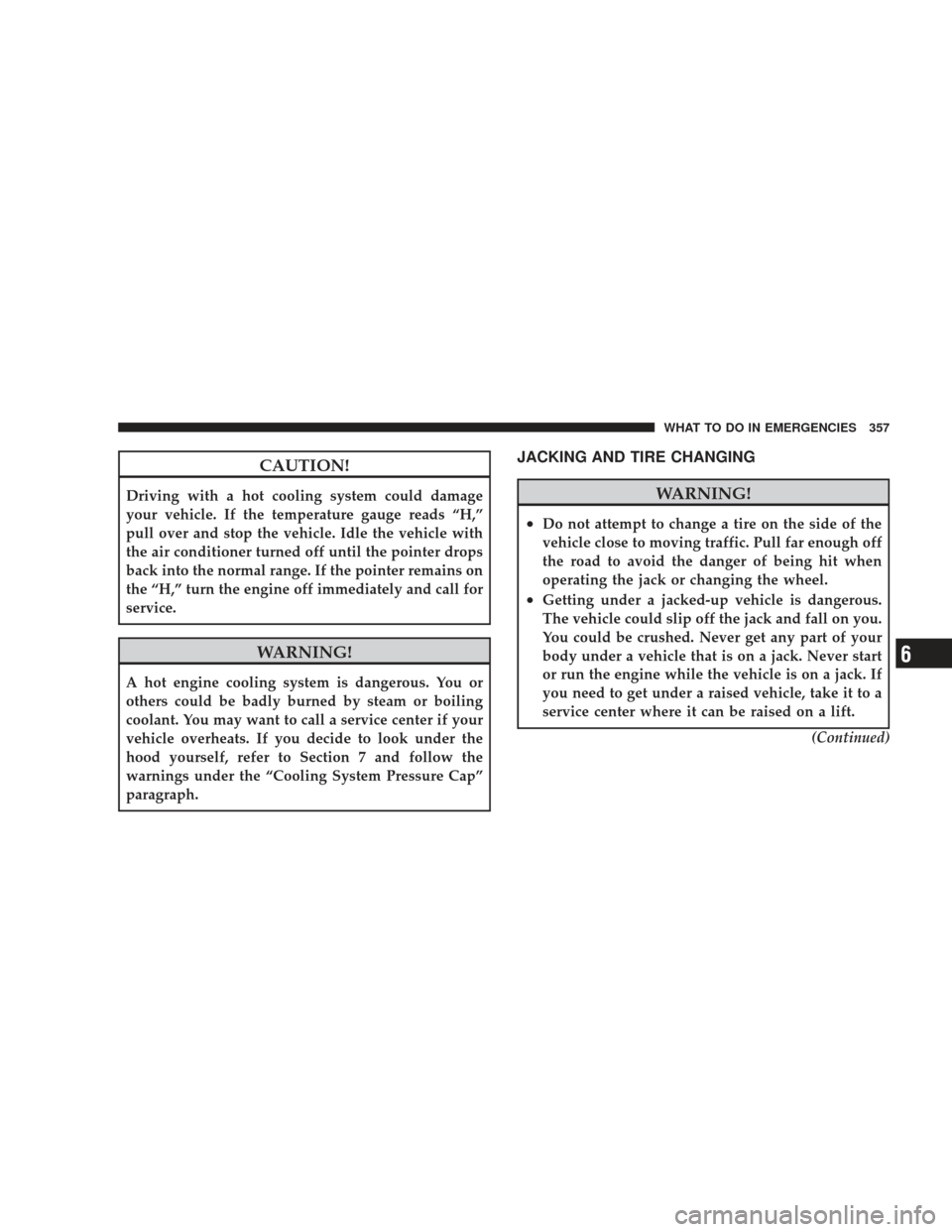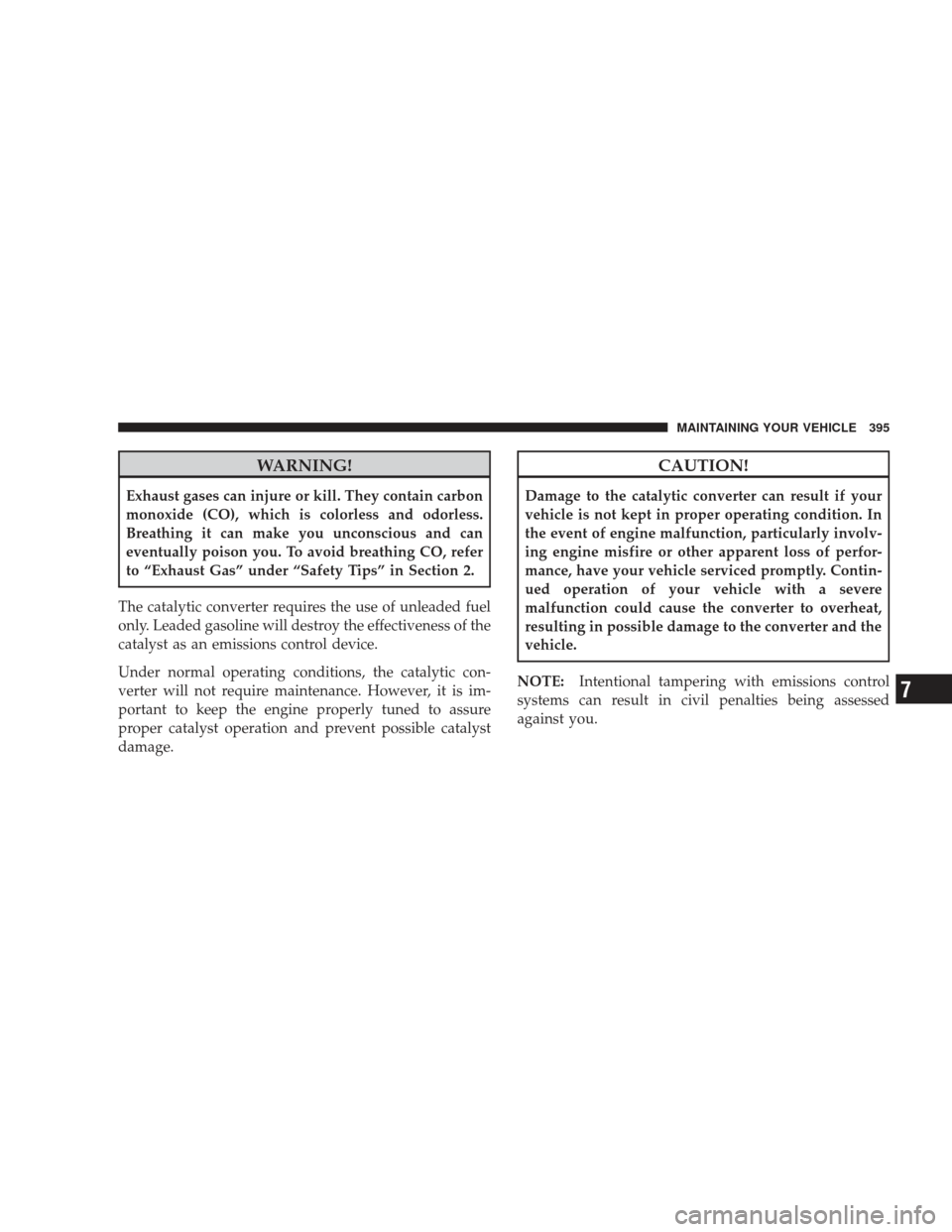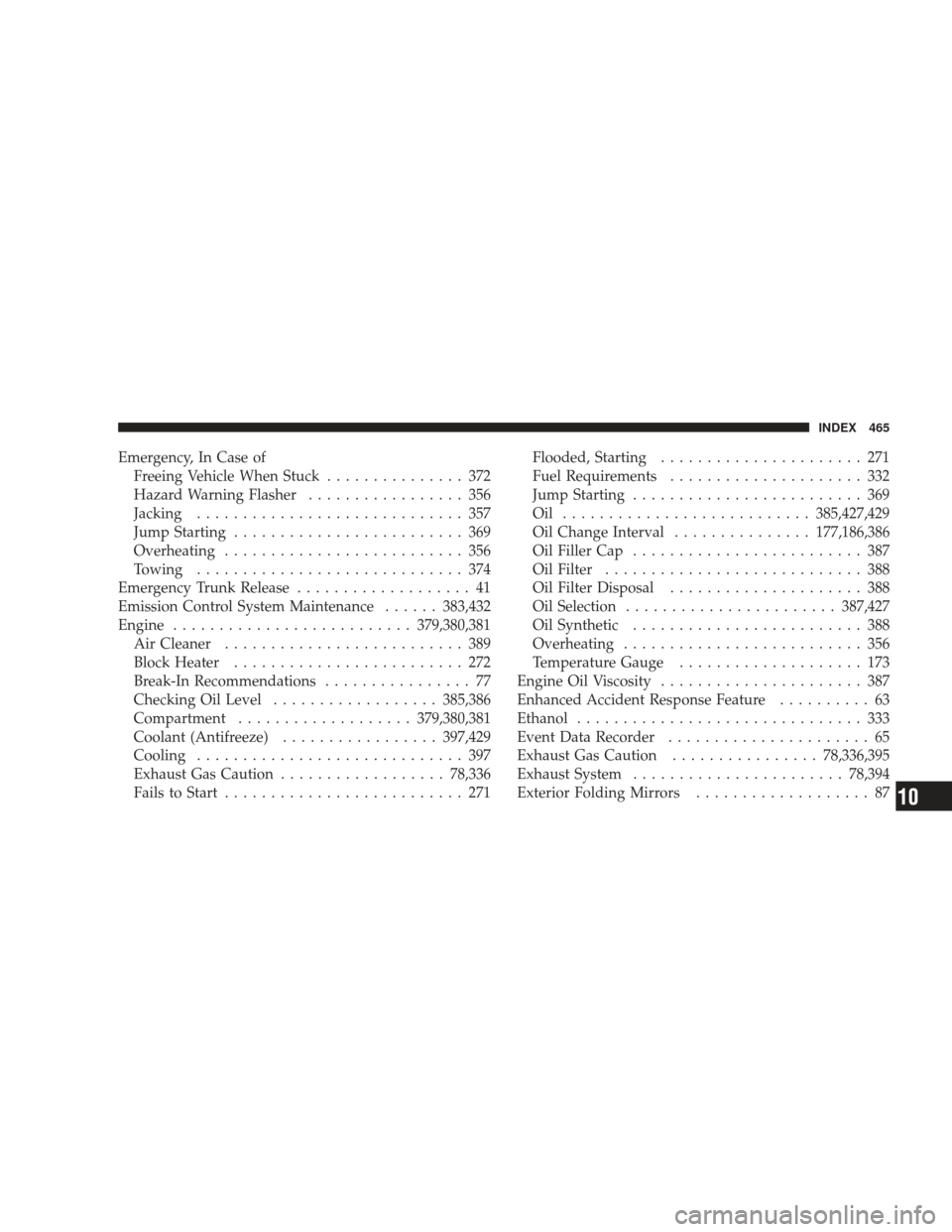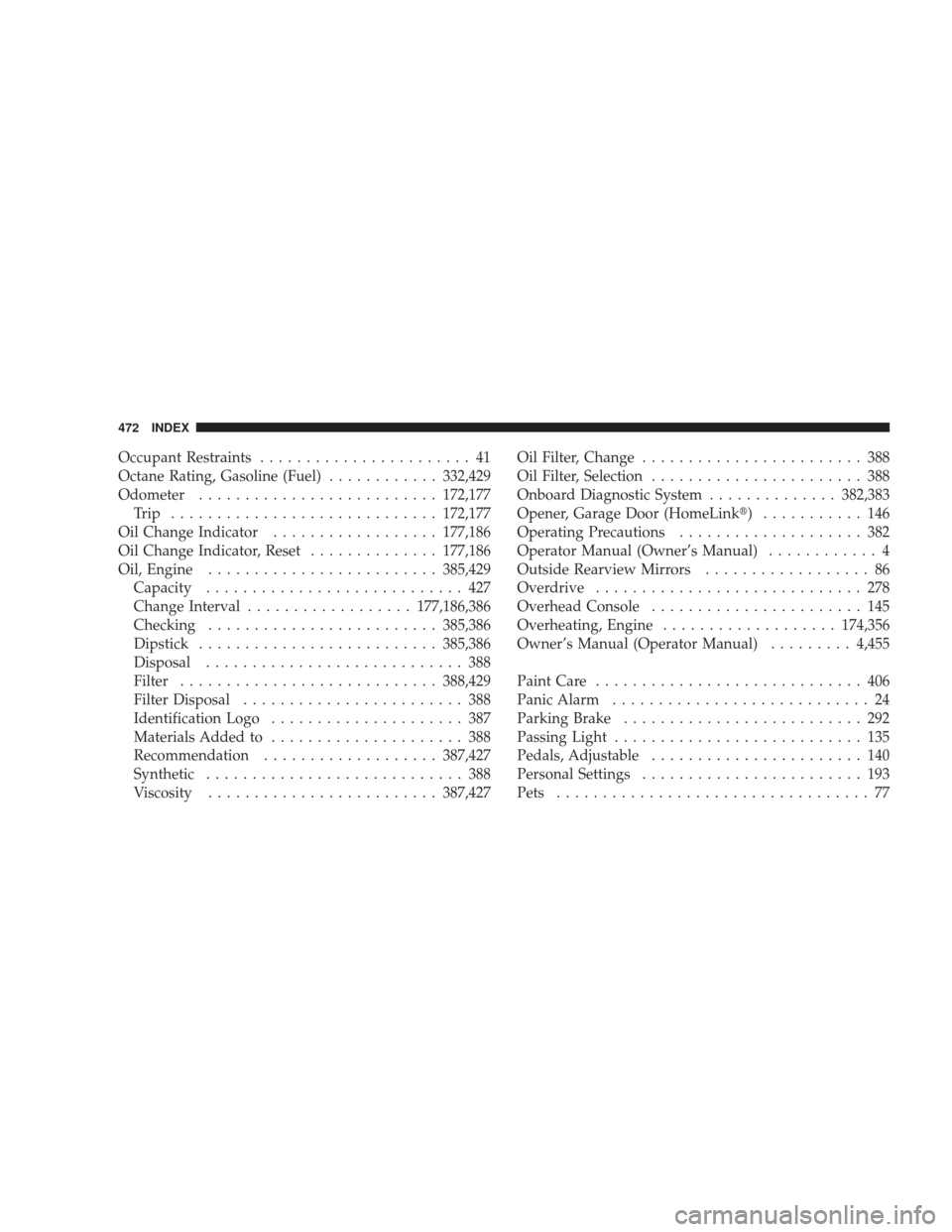Page 359 of 484

CAUTION!
Driving with a hot cooling system could damage
your vehicle. If the temperature gauge reads “H,”
pull over and stop the vehicle. Idle the vehicle with
the air conditioner turned off until the pointer drops
back into the normal range. If the pointer remains on
the “H,” turn the engine off immediately and call for
service.
WARNING!
A hot engine cooling system is dangerous. You or
others could be badly burned by steam or boiling
coolant. You may want to call a service center if your
vehicle overheats. If you decide to look under the
hood yourself, refer to Section 7 and follow the
warnings under the “Cooling System Pressure Cap”
paragraph.
JACKING AND TIRE CHANGING
WARNING!
•Do not attempt to change a tire on the side of the
vehicle close to moving traffic. Pull far enough off
the road to avoid the danger of being hit when
operating the jack or changing the wheel.
•Getting under a jacked-up vehicle is dangerous.
The vehicle could slip off the jack and fall on you.
You could be crushed. Never get any part of your
body under a vehicle that is on a jack. Never start
or run the engine while the vehicle is on a jack. If
you need to get under a raised vehicle, take it to a
service center where it can be raised on a lift.(Continued)
WHAT TO DO IN EMERGENCIES 357
6
Page 375 of 484
CAUTION!
•When “rocking” a stuck vehicle by moving be-
tween 1st and REVERSE, do not spin the wheels
faster than 15 mph (24 km/h), or drivetrain damage
may result.
•Racing the engine or spinning the wheels too fast
may lead to transmission overheating and failure.
It can also damage the tires. Do not spin the
wheels above 35 mph (55 km/h).
WARNING!
Fast spinning tires can be dangerous. Forces gener-
ated by excessive wheel speeds may cause tire dam-
age or failure. A tire could explode and injure some-
one. Do not spin your vehicle’s wheels faster than
35 mph (55 km/h) when you are stuck, and don’t let
anyone near a spinning wheel, no matter what the
speed.
WHAT TO DO IN EMERGENCIES 373
6
Page 397 of 484

WARNING!
Exhaust gases can injure or kill. They contain carbon
monoxide (CO), which is colorless and odorless.
Breathing it can make you unconscious and can
eventually poison you. To avoid breathing CO, refer
to “Exhaust Gas” under “Safety Tips” in Section 2.
The catalytic converter requires the use of unleaded fuel
only. Leaded gasoline will destroy the effectiveness of the
catalyst as an emissions control device.
Under normal operating conditions, the catalytic con-
verter will not require maintenance. However, it is im-
portant to keep the engine properly tuned to assure
proper catalyst operation and prevent possible catalyst
damage.
CAUTION!
Damage to the catalytic converter can result if your
vehicle is not kept in proper operating condition. In
the event of engine malfunction, particularly involv-
ing engine misfire or other apparent loss of perfor-
mance, have your vehicle serviced promptly. Contin-
ued operation of your vehicle with a severe
malfunction could cause the converter to overheat,
resulting in possible damage to the converter and the
vehicle.
NOTE: Intentional tampering with emissions control
systems can result in civil penalties being assessed
against you.
MAINTAINING YOUR VEHICLE 395
7
Page 398 of 484

WARNING!
A hot exhaust system can start a fire if you park over
materials that can burn. Such materials might be
grass or leaves coming into contact with your exhaust
system. Do not park or operate your vehicle in areas
where your exhaust system can contact anything that
can burn.
In unusual situations involving grossly malfunctioning
engine operation, a scorching odor may indicate severe
and abnormal catalyst overheating. If this should occur,
safely bring the vehicle to a complete stop, shut the
engine OFF, and allow the vehicle to cool. Thereafter,
obtain service, including a tune-up to manufacturer’s
specifications immediately. To minimize the possibility of catalyst damage:•Do not shut off the engine or interrupt the ignition
when the transmission is in gear and the vehicle is in
motion.
•Do not try to start the engine by pushing or towing the
vehicle.
•Do not idle the engine with any spark plug wires
disconnected or removed, such as when diagnostic
testing, or for prolonged periods during very rough
idling or malfunctioning operating conditions.
396 MAINTAINING YOUR VEHICLE
Page 402 of 484

NOTE:Mixing engine coolant (antifreeze) types will
decrease the life of the engine coolant (antifreeze) and
will require more frequent engine coolant (antifreeze)
changes.
Cooling System Pressure Cap
The cap must be fully tightened to prevent loss of
coolant, and to ensure that engine coolant (antifreeze)
will return to the radiator from the coolant recovery
bottle.
The cap should be inspected and cleaned if there is any
accumulation of foreign material on the sealing surfaces.
WARNING!
•The warning words “DO NOT OPEN HOT” on
the cooling system pressure cap are a safety pre-
caution. Never add engine coolant (antifreeze)
when the engine is overheated. Do not loosen or
remove the cap to cool an overheated engine. Heat
causes pressure to build up in the cooling system.
To prevent scalding or injury, do not remove the
pressure cap while the system is hot or under
pressure.
•Do not use a pressure cap other than the one
specified for your vehicle. Personal injury or en-
gine damage may result.
Disposal of Used Coolant
Used ethylene glycol-based engine coolant (antifreeze) is
a regulated substance requiring proper disposal. Check
with your local authorities to determine the disposal
400 MAINTAINING YOUR VEHICLE
Page 467 of 484

Emergency, In Case ofFreeing Vehicle When Stuck ............... 372
Hazard Warning Flasher ................. 356
Jacking ............................. 357
Jump Starting ......................... 369
Overheating .......................... 356
Towing ............................. 374
Emergency Trunk Release ................... 41
Emission Control System Maintenance ......383,432
Engine .......................... 379,380,381
Air Cleaner .......................... 389
Block Heater ......................... 272
Break-In Recommendations ................ 77
Checking Oil Level .................. 385,386
Compartment ................... 379,380,381
Coolant (Antifreeze) ................. 397,429
Cooling ............................. 397
Exhaust Gas Caution .................. 78,336
Fails to Start .......................... 271 Flooded, Starting
...................... 271
Fuel Requirements ..................... 332
Jump Starting ......................... 369
Oil ........................... 385,427,429
Oil Change Interval ...............177,186,386
Oil Filler Cap ......................... 387
Oil Filter ............................ 388
Oil Filter Disposal ..................... 388
Oil Selection ....................... 387,427
Oil Synthetic ......................... 388
Overheating .......................... 356
Temperature Gauge .................... 173
Engine Oil Viscosity ...................... 387
Enhanced Accident Response Feature .......... 63
Ethanol ............................... 333
Event Data Recorder ...................... 65
Exhaust Gas Caution ................78,336,395
Exhaust System ....................... 78,394
Exterior Folding Mirrors ................... 87
INDEX 465
10
Page 474 of 484

Occupant Restraints....................... 41
Octane Rating, Gasoline (Fuel) ............332,429
Odometer .......................... 172,177
Trip ............................. 172,177
Oil Change Indicator .................. 177,186
Oil Change Indicator, Reset ..............177,186
Oil, Engine ......................... 385,429
Capacity ............................ 427
Change Interval .................. 177,186,386
Checking ......................... 385,386
Dipstick .......................... 385,386
Disposal ............................ 388
Filter ............................ 388,429
Filter Disposal ........................ 388
Identification Logo ..................... 387
Materials Added to ..................... 388
Recommendation ................... 387,427
Synthetic ............................ 388
Viscosity ......................... 387,427Oil Filter, Change
........................ 388
Oil Filter, Selection ....................... 388
Onboard Diagnostic System ..............382,383
Opener, Garage Door (HomeLink�) ........... 146
Operating Precautions .................... 382
Operator Manual (Owner’s Manual) ............ 4
Outside Rearview Mirrors .................. 86
Overdrive ............................. 278
Overhead Console ....................... 145
Overheating, Engine ................... 174,356
Owner’s Manual (Operator Manual) .........4,455
Paint Care ............................. 406
Panic Alarm ............................ 24
Parking Brake .......................... 292
Passing Light ........................... 135
Pedals, Adjustable ....................... 140
Personal Settings ........................ 193
Pets .................................. 77
472 INDEX